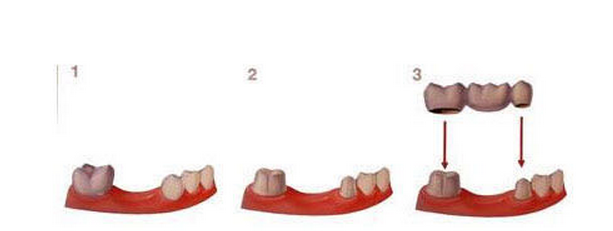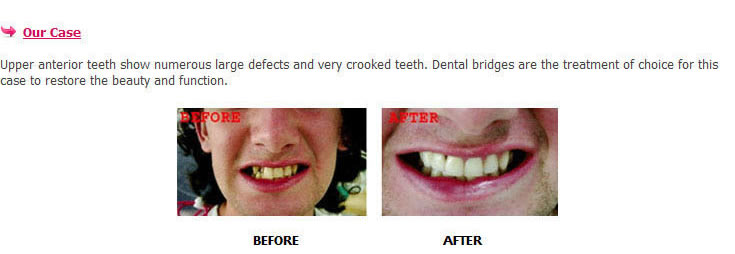Dental Crown & Bridge
DENTAL CROWN
Crown is a dental restoration that completely caps or encircles a tooth that is damaged or decayed, or following a dental implant, or to replace a missing tooth that encompasses a bridge. Crowns, when cemented into place, fully cover the visible portion of the tooth that lies at and above the gum line.
E-max Porcelain Crown
The most common crown these days, if we take into consideration both esthetic and functionality, is the all porcelain crowns which can be LAVA, CERCON, PROCERA, EMAX, and BRUXZIR. Each type of these full porcelain crowns represents a composition that will best suit your needs or conditions. For posterior teeth, taking into consideration cost-effective materials, there is the Porcelain Fused to Metal crown. And we at BSDC take pride in saying that we have our very own In-House laboratory to fabricate these types of crowns. We bring efficiency, quality and technology in our services.
As there many factors to consider in choosing a crown, such as, strength of the material, the expertise of the dental specialist/ dentist, the skills of the dental ceramists and/or lab technicians, and of course, as with many of our patients come from overseas, TIME, which is also a big factor, should also be taken into consideration. We know that in seeking treatments in Thailand, Time is always of the essence, with the joint effort of our Skillful and competent Prosthodontists and our highly trained technicians that received advanced training in ceramics and CAD/CAM technology, we can restore your teeth with most regard to quality and esthetics, and functionality.

DIFFERENT TYPES OF FULL PORCELAIN CROWNS
Zirconia
1. LAVA CROWN is a transluscent Zirconia which is a milled ceramic on the inside and is innovatively computer-aided in design. This is made up of all ceramic zirconia. Ziconia crowns are in demand in the field of cosmetic dentistry now a days because of their superior properties, their biocompatibility and strength which is not found in other full porcelain crowns. They also have a translucent quality that is similar to our original teeth. Hence, if you’re looking at a natural-looking restoration that is superior in quality, does improving your smile dramatically, Lava crowns may just be the one for you.
2. BRUXZIR CROWN is an alternative to porcelain fused to metal crowns in restoring posterior teeth. They are composed of full zirconia crown and are ideal for people with teeth grinding disorder, otherwise known as Bruxers, as they are chip-proof free.
3. PROCERA CROWN is another type of ceramic crown that is metal free, gum friendly, and is usually fabricated outside the dentist’s office. For other practitioners, this means bringing the work elsewhere thus time-consuming, but because BSDC has their own in-house laboratory, the fabrication of the crown is made within our premises, less time required, and can be periodically checked by the dentist if it is being done according to specification.
4. CERCON CROWN offers dependable strength and esthetics as well. The preparation of this crown is also aided by computer aided, thus allowing a precise or custom design. It is also translucent and biocompatible.
5. EMAX CROWN is made of lithium disilicate ceramic that is highly esthetic and a little less expensive than full zirconia crowns and are ideal for restoring single posterior and anterior teeth.
DENTAL BRIDGES
Missing tooth is a great concern, may it be from extraction, or injury, it can lead to issues like eruption of the opposing tooth from their sockets created by the empty space left by the one missing. It can also alter the way words are pronounced or delivered, hence impairing your speech. The gap left by the missing tooth can also result in other teeth drifting towards the empty space. Dental bridges, like implants and partial dentures are the options for replacing a missing tooth or teeth.
KINDS OF DENTAL BRIDGES
Dental Bridges may be Traditional Fixed Bridge, Resin Bonded Bridge, and Cantilever Bridge. With the clamor for both esthetic and durability for cosmetic dentistry and/or restoration, dental bridges when combined with the best material like full zirconia crowns, can recreate natural-looking and fully functional teeth and smile.
1.Traditional Bridge is the most common type, having two crowns holding into place a false tooth that replaces the missing one. It can be made to replace one or more missing teeth.
2. For the front teeth, Resin Bonded Bridge is a less expensive choice. In this type of bridge, metal bonds are bonded to abutment teeth instead of capping them with crowns. The metal bands are fused at the back of the abutments, and require less preparation.
3. Cantilever Bridges on the other hand are used when there is no tooth on the other side of the missing gap to serve as abutment. In other words, the pontic is anchored to one side only, and can be fused with one tooth or more of the adjacent teeth. However, this type of bridge is not advisable to teeth that are under heavy stress.
GENERAL INFORMATION ON CROWNS AND BRIDGES
WHAT ARE THE REASONS FOR PLACING CROWNS ?
Full mouth rehabilitation
• The tooth has been broken or severely damaged by decay, which would make fillings insufficient to replace enough of the tooth or wouldn’t make the tooth strong enough to fully withstand the activities of the mouth like chewing, and worse, tooth grinding (Bruxism).
• Protect a root canal treated tooth
• Crowns are also used to hold a bridge in place.
• Crowns can be used to improve tooth appearance, or to cover misshapen or severely discolored teeth.
• To cover a dental implant.
WHAT ARE THE DIFFERENT TYPES OF CROWNS ?
PFM/Full Metal
• All Porcelain / Ceramic (metal free) Crowns provides better natural tooth color match than all the other types of crowns. All Porcelain crowns are made of a biocompatible material which minimizes the risk of allergic reactions. And because of its modified core materials, this type of crown is now suitable for teeth reconstruction wherever tooth is positioned.
• Another type of crown is the Porcelain Fused to Metal Crowns which can be colored to match the adjacent teeth. It is a shell of metal custom fitted to affected tooth, and a coat of veneer of porcelain is then fused over this metal. The downside to this type of crown is the fact that the porcelain portion is prone to fracture more than an all-metal dental crown. Next to an All Porcelain Crown, Porcelain Fused to metal look most like natural teeth, but underlying the porcelain can show through as a dark line, especially at the gum line.
• Stainless Steel crowns are primarily used as a temporary measure. Normally used for children, to protect the teeth from further decay. As the primary tooth comes out, the crown comes out naturally with it.
Full Metal Gold
• All Metal Crowns (gold or another alloy – palladium, nickel, or chromium) are a good choice for out-of-sight or rear teeth. The advantage of this type of crown is that less tooth structure is needed to be removed, tooth wear to apposing teeth is kept to a minimum, and last the longest in terms of wear and tear.
WHAT IF THERE IS INADEQUATE TOOTH ROOT LEFT TO SUPPORT A CROWN, FOLLOWING A RESTORATION OF A BIG DECAY? WOULD EXTRACTION BE THE REMEDY ?
There would be times when tooth decay is too big that when it is cleaned down, not enough tooth structure is left. Would extraction be our option? As we have emphasized in our discussion on IMPLANT treatment, a tooth, no matter how little is left after it is saved, is most preferable to maintain the bone density in our jaw. If there isn’t enough tooth structure left to maintain restoration, we resort to POST and CORE before we do the crowns.
HOW IS DENTAL CROWN TREATMENT DONE IN OUR CLINIC ?
The current condition of the tooth is examined and prepared. There might be a need for an x ray to examine the root of the tooth or teeth to be crowned. This is usually done when the decay is big to determine if there is risk of infection or there is injury to the nerve. In which case, Root Canal Treatment may be performed first.If the tooth is ready for the crown, anesthesia is used to numb the gum tissue around the tooth, and the chewing surface is filed down to prepare it for the crown.An impression is taken of the tooth receiving the crown; this impression is then sent to our in-house laboratory for fabrication. While the crown is being made, a temporary crown, usually made of acrylic, is cemented to the prepared tooth in order to protect it.
Several days after, crown is fitted to the prepared natural teeth. Adjustments will be made, if there are any, before it is finally cemented permanently.
Another appointment will be requested for recheck, to guarantee, that all is well before the patient head home.
DENTAL BRIDGES
Dental bridges, like implants and partial dentures are the options for replacing a missing tooth or teeth.
WHAT ARE THE BENEFITS OF DENTAL BRIDGES ?
Dental bridges appear and function similar to natural teeth. As compared to dentures, they remain in the mouth at all times, and they are less costly than implants. They are recommended for those who have one or a few missing teeth.
HOW LONG DO THEY LAST ?
They can last up to 10 – 20 years with proper oral care and dental checkups. Good oral hygiene, such as brushing and flossing, should be maintained, otherwise, once decay sets in, the dentist will be forced to remove the bridge

WHAT IS THE PROCEDURE ?
The dentist will have to examine your teeth, whether they are in good condition. If they are, the procedure may proceed, if they are not, the teeth should receive treatment first. Just in the case of decayed teeth, then this would have to be repaired first.
In case the teeth that to be used as abutments are alright, anesthetic is administered locally to ensure you will feel no pain throughout the treatment. An impression of your teeth is taken before they are trim down. When this is done, an impression is taken of the trimmed down teeth will be taken. This will be the basis of the bridge that is to be prepared in the dental laboratory for fabrication. Before leaving, a temporary bridge will be fitted to protect the teeth and gums while waiting for the permanent one.
On your next appointment, the permanent bridge will be tried, to see how it would fit and feel before it is cemented into place. Minor adjustments will be done in case there are any.
Sea Smile International Dental Clinic Patong | Dental Clinic Patong | Dental Clinic Phuket | Dental Patong | Dental Phuket | Dentist Patong | Phuket Dentist | Phuket Dentist Makeover | Patong Invisalign | Dentist in Phuket | Phuket Laser whitening | Dental Clinic In Phuket | Dentists In Phuket | Dentists In Phuket Patong Relate | Patong dental bridge | Dental crown in Patong | Phuket dental clinic | Patong implants | Dentist Surgery Patong | Dental Clinic In Patong Beach | Patong Dental Cosmetic
